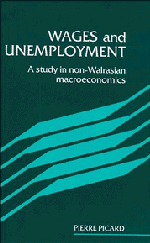Book contents
- Frontmatter
- Contents
- Acknowledgements
- Introduction
- 1 Price rigidities and temporary equilibrium
- 2 Wage rigidity and short-run macroeconomic equilibrium
- 3 Real wages and the inflation—unemployment dilemma
- 4 External constraint, oil shock and economic policy
- 5 Implicit contracts and unions
- 6 Introduction to efficiency wage models
- 7 Efficiency wages, employment fluctuations and fiscal policy
- 8 Labour market dualism, efficiency wages and optimal taxation
- Notes
- References
- Author index
- Subject index
7 - Efficiency wages, employment fluctuations and fiscal policy
Published online by Cambridge University Press: 28 October 2009
- Frontmatter
- Contents
- Acknowledgements
- Introduction
- 1 Price rigidities and temporary equilibrium
- 2 Wage rigidity and short-run macroeconomic equilibrium
- 3 Real wages and the inflation—unemployment dilemma
- 4 External constraint, oil shock and economic policy
- 5 Implicit contracts and unions
- 6 Introduction to efficiency wage models
- 7 Efficiency wages, employment fluctuations and fiscal policy
- 8 Labour market dualism, efficiency wages and optimal taxation
- Notes
- References
- Author index
- Subject index
Summary
The basic idea underlying efficiency wage theory is that there is a link between workers' productivity and the wages they receive. As seen in the previous chapter, the relationship mainly lies in a situation of asymmetric information. In adverse selection models, the firm cannot distinguish the most efficient workers from the less efficient and a worker's ability is assumed to be correlated with his reservation wage. Then in a situation of involuntary unemployment, the firm may choose not to decrease wages so that the most productive individuals do not give up applying for the jobs. In moral hazard models, individuals' performances depend on their behaviour which cannot be perfectly monitored by employers. Offering higher wages makes the cost of losing one's job higher and thus urges workers to make every effort required to keep their jobs. In other models, a wage policy is a means of stabilizing the labour force when turnover is costly. Finally, in analyses of sociological inspiration, the wage policy is the product of social conventions determining work rules and collective productivity standards.
All these models show that real wage rigidity within an involuntary unemployment context is perfectly compatible with a competitive labour market. However, if the efficiency wage theory explains the existence of involuntary unemployment, using it as an element of macroeconomic analysis aiming at explaining the fluctuations in output and employment is not self-evident.
- Type
- Chapter
- Information
- Wages and UnemploymentA Study in Non-Walrasian Macroeconomics, pp. 199 - 228Publisher: Cambridge University PressPrint publication year: 1993



